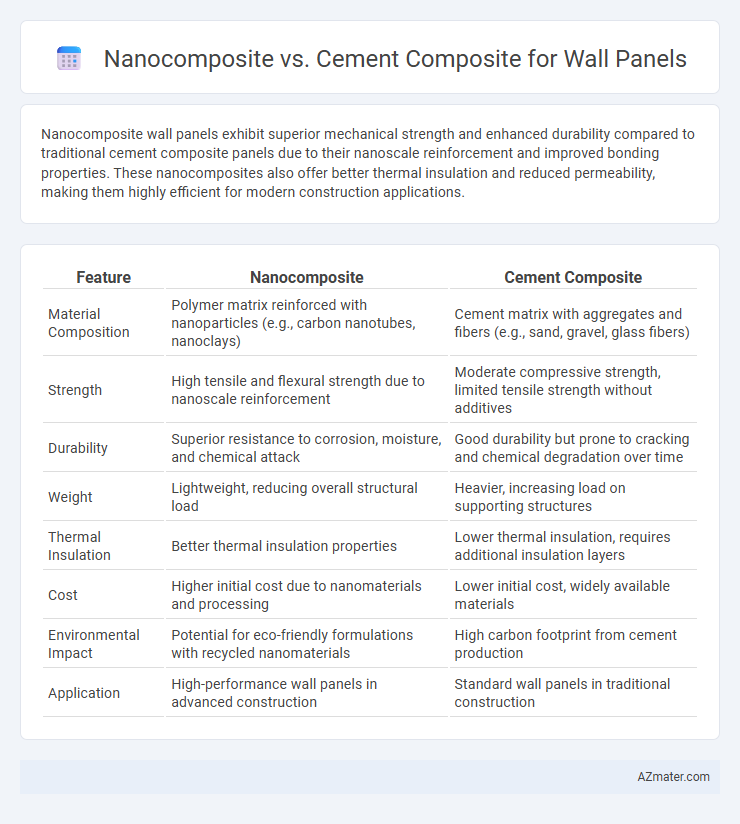Nanocomposite wall panels exhibit superior mechanical strength and enhanced durability compared to traditional cement composite panels due to their nanoscale reinforcement and improved bonding properties. These nanocomposites also offer better thermal insulation and reduced permeability, making them highly efficient for modern construction applications.
Table of Comparison
| Feature | Nanocomposite | Cement Composite |
|---|---|---|
| Material Composition | Polymer matrix reinforced with nanoparticles (e.g., carbon nanotubes, nanoclays) | Cement matrix with aggregates and fibers (e.g., sand, gravel, glass fibers) |
| Strength | High tensile and flexural strength due to nanoscale reinforcement | Moderate compressive strength, limited tensile strength without additives |
| Durability | Superior resistance to corrosion, moisture, and chemical attack | Good durability but prone to cracking and chemical degradation over time |
| Weight | Lightweight, reducing overall structural load | Heavier, increasing load on supporting structures |
| Thermal Insulation | Better thermal insulation properties | Lower thermal insulation, requires additional insulation layers |
| Cost | Higher initial cost due to nanomaterials and processing | Lower initial cost, widely available materials |
| Environmental Impact | Potential for eco-friendly formulations with recycled nanomaterials | High carbon footprint from cement production |
| Application | High-performance wall panels in advanced construction | Standard wall panels in traditional construction |
Introduction to Wall Panel Materials
Nanocomposites for wall panels incorporate nanoscale fillers such as carbon nanotubes or nano-silica, enhancing mechanical strength, thermal insulation, and durability compared to traditional cement composites made from Portland cement, aggregates, and additives. Cement composites are widely used due to cost-effectiveness and ease of production but often suffer from limited tensile strength and higher permeability. The integration of nanomaterials in wall panels significantly improves performance characteristics, making nanocomposites a promising alternative in advanced construction applications.
Overview of Cement Composite Panels
Cement composite panels consist of cementitious binders combined with aggregates, fibers, and additives, offering enhanced durability, fire resistance, and moisture tolerance for wall applications. These panels provide structural integrity with improved thermal and acoustic insulation properties, making them suitable for both interior and exterior use. Compared to nanocomposites, cement composites are more established with widespread industry adoption and cost-effective manufacturing processes.
Understanding Nanocomposite Panels
Nanocomposite panels integrate nanoparticles into traditional cement composites, enhancing mechanical strength and durability for wall applications. These panels exhibit superior thermal insulation, reduced porosity, and increased resistance to environmental degradation compared to conventional cement composites. Advanced nanomaterials such as carbon nanotubes and nano-silica improve fracture toughness and water resistance, making nanocomposite panels a cutting-edge solution for sustainable building walls.
Material Composition: Cement vs Nanocomposite
Cement composites for wall panels primarily consist of Portland cement, aggregates, and water, forming a rigid matrix with moderate mechanical strength and durability. Nanocomposites incorporate nanoscale materials such as nanosilica, carbon nanotubes, or graphene oxide into a cementitious or polymer matrix, significantly enhancing mechanical properties, thermal insulation, and resistance to cracking. The addition of nanoparticles refines the microstructure, resulting in improved density, strength, and long-term durability compared to traditional cement composites.
Mechanical Properties Comparison
Nanocomposite wall panels exhibit superior mechanical properties compared to traditional cement composites, offering enhanced tensile strength, increased flexural modulus, and improved fracture toughness. The integration of nanomaterials, such as carbon nanotubes or nano-silica, significantly strengthens the interfacial bonding within the matrix, resulting in higher impact resistance and durability. Consequently, nanocomposites provide greater load-bearing capacity and longevity, making them more effective for advanced structural applications in wall panel construction.
Thermal and Acoustic Insulation Performance
Nanocomposite wall panels exhibit superior thermal insulation due to their enhanced nanoscale filler distribution, which reduces heat transfer more effectively than traditional cement composites. Acoustic insulation in nanocomposite panels benefits from the integration of nanoparticle materials that absorb and dissipate sound waves, outperforming conventional cement composites. These advanced nanocomposite materials offer higher efficiency in maintaining indoor temperature and minimizing noise pollution, making them ideal for energy-saving and soundproof wall panel applications.
Durability and Lifespan Analysis
Nanocomposite wall panels exhibit superior durability and an extended lifespan compared to traditional cement composites due to enhanced matrix bonding and improved resistance to microcracking. The incorporation of nanoparticles such as nano-silica or carbon nanotubes significantly increases mechanical strength, reduces permeability, and enhances resistance to environmental degradation, leading to longer service life in harsh conditions. Cement composites, while cost-effective, typically show higher susceptibility to shrinkage, cracking, and weathering, resulting in comparatively shorter durability and frequent maintenance needs.
Environmental Impact and Sustainability
Nanocomposite wall panels exhibit superior environmental performance compared to traditional cement composites due to their enhanced durability and reduced material consumption, lowering carbon footprints throughout the product lifecycle. The incorporation of nanoscale reinforcements improves thermal insulation and reduces energy demand for heating and cooling in buildings, contributing significantly to sustainability goals. Cement composites generate higher CO2 emissions during production and often require more maintenance, which increases environmental burdens over time.
Cost-effectiveness and Market Availability
Nanocomposite wall panels offer superior durability and lightweight properties but remain costly due to advanced materials like carbon nanotubes, limiting widespread market availability. Cement composites are highly cost-effective, utilizing readily available materials such as cement, sand, and aggregates, making them the dominant choice for wall panels globally. Market adoption favors cement composites for large-scale construction projects due to their affordability and established supply chains, despite nanocomposites presenting future potential for high-performance applications.
Future Trends in Wall Panel Technology
Nanocomposite wall panels integrate nanoparticles such as carbon nanotubes and silica to significantly enhance mechanical strength, thermal insulation, and durability compared to traditional cement composites. Future trends emphasize sustainable, lightweight nanocomposites with superior fire resistance and self-healing capabilities to meet evolving construction standards and environmental regulations. Advancements in nanotechnology promise smarter wall panels with embedded sensors for real-time structural health monitoring and energy efficiency optimization.

Infographic: Nanocomposite vs Cement composite for Wall panel
 azmater.com
azmater.com